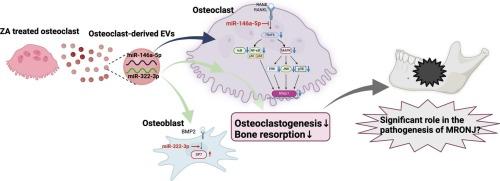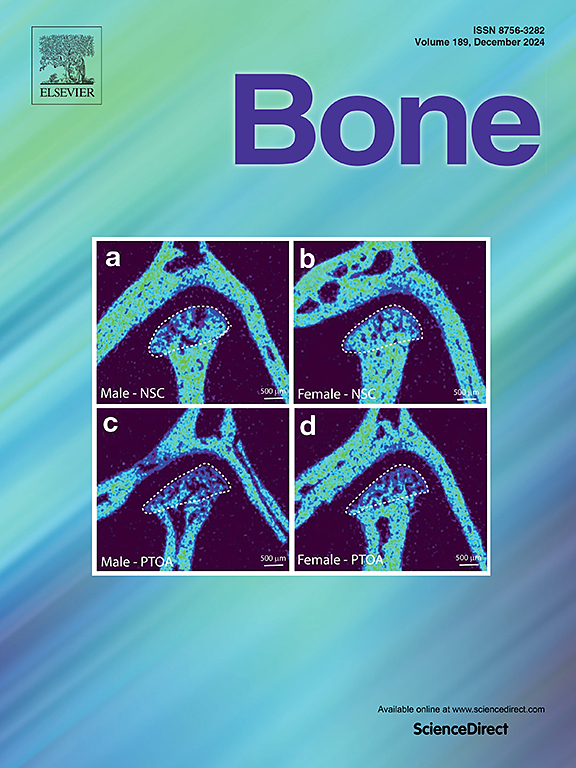Extracellular vesicles from mouse bone marrow macrophages-derived osteoclasts treated with zoledronic acid contain miR-146a-5p and miR-322-3p, which inhibit osteoclast function
IF 3.6
2区 医学
Q2 ENDOCRINOLOGY & METABOLISM
引用次数: 0
Abstract
Medication-related osteonecrosis of the jaw (MRONJ) is an intractable form of osteonecrosis of the jaw that rarely occurs in patients using bone resorption inhibitors such as bisphosphonates (BPs). Then, extracellular vesicles (EVs) carry various signaling molecules, such as mRNAs, microRNAs (miRNAs), and proteins, and have attracted attention as intercellular communication tools. Recently, the role of EVs in communication between osteoclasts and surrounding bone cells has been confirmed. This study aimed to elucidate the effects of EVs derived from osteoclasts treated with zoledronic acid (ZA), one of the BPs on osteoclast function. EVs were isolated by ultracentrifugation of the culture supernatant of osteoclasts treated with ZA, and miRNAs were extracted from these EVs. Tartrate-resistant acid phosphatase staining of the ZA treated osteoclasts showed reduced osteoclastogenesis. In addition, pit assay showed that ZA significantly decreased the bone resorption capacity of osteoclasts. miRNA-seq analysis identified 11 upregulated and 5 downregulated differentially expressed genes (DEGs) in the miRNA of EVs derived from ZA-treated osteoclasts compared to EVs derived from osteoclasts not treated with ZA. qRT-PCR analysis confirmed the amount of these specific miRNAs, with miR-146a-5p, and miR-322-3p being significantly upregulated by ZA. Overexpression of miR-146a-5p in osteoclasts inhibited osteoclastogenesis and decreased the mRNA expression of osteoclast markers. In addition, Traf6 was identified as a candidate target gene of miR-146a-5p in several miRNA databases. Indeed, the overexpression of miR-146a-5p decreased the expression level of Traf6 in osteoclasts. Additionally, overexpression of miR-322-3p in the pre-osteoblast, MC3T3-E1 cells, resulted in a significant increase in the mRNA expression levels of Sp7. Our data indicate that BPs attenuate osteoclastogenesis by simultaneously altering the characteristics of osteoclast-derived EVs. Overexpression of miR-146a-5p and miR-322-3p influences osteoclast differentiation, and Traf6 is a target gene of miR-146a-5p. On the other hand, Overexpression of miR-322-3p affects osteoblast differentiation. We suggest that ZA-treated osteoclast-derived EVs may play an important role in osteoclast function and bone resorption.

用唑来膦酸处理小鼠骨髓巨噬细胞衍生的破骨细胞的胞外囊泡含有抑制破骨细胞功能的miR-146a-5p和miR-322-3p。
药物相关性颌骨坏死(MRONJ)是一种难治性颌骨坏死,很少发生在使用双膦酸盐(BPs)等骨吸收抑制剂的患者身上。细胞外囊泡(EVs)携带各种信号分子,如 mRNA、microRNA(miRNA)和蛋白质,作为细胞间通信工具备受关注。最近,EVs 在破骨细胞与周围骨细胞之间的通讯中的作用得到了证实。本研究旨在阐明破骨细胞接受唑来膦酸(ZA)(BPs之一)治疗后产生的EVs对破骨细胞功能的影响。研究人员通过超速离心法分离了用唑来膦酸处理的破骨细胞的培养上清液中的EVs,并从这些EVs中提取了miRNA。对经ZA处理的破骨细胞进行耐酒石酸磷酸酶染色显示破骨细胞生成减少。miRNA-seq 分析发现,与未用 ZA 处理的破骨细胞的 EVs 相比,用 ZA 处理的破骨细胞的 EVs 的 miRNA 中有 11 个上调和 5 个下调的差异表达基因(DEGs)。qRT-PCR 分析证实了这些特定 miRNA 的数量,其中 miR-146a-5p 和 miR-322-3p 受 ZA 的影响显著上调。在破骨细胞中过表达 miR-146a-5p 可抑制破骨细胞的生成,并降低破骨细胞标志物的 mRNA 表达。此外,在多个 miRNA 数据库中,Traf6 被确定为 miR-146a-5p 的候选靶基因。事实上,过表达 miR-146a-5p 会降低破骨细胞中 Traf6 的表达水平。此外,在前成骨细胞 MC3T3-E1 细胞中过表达 miR-322-3p 会导致 Sp7 的 mRNA 表达水平显著增加。我们的数据表明,BPs 可通过同时改变破骨细胞衍生 EVs 的特性来抑制破骨细胞的生成。miR-146a-5p和miR-322-3p的过表达会影响破骨细胞的分化,而Traf6是miR-146a-5p的靶基因。另一方面,miR-322-3p 的过表达会影响成骨细胞的分化。我们认为ZA处理的破骨细胞衍生EVs可能在破骨细胞功能和骨吸收中发挥重要作用。
本文章由计算机程序翻译,如有差异,请以英文原文为准。
求助全文
约1分钟内获得全文
求助全文
来源期刊

Bone
医学-内分泌学与代谢
CiteScore
8.90
自引率
4.90%
发文量
264
审稿时长
30 days
期刊介绍:
BONE is an interdisciplinary forum for the rapid publication of original articles and reviews on basic, translational, and clinical aspects of bone and mineral metabolism. The Journal also encourages submissions related to interactions of bone with other organ systems, including cartilage, endocrine, muscle, fat, neural, vascular, gastrointestinal, hematopoietic, and immune systems. Particular attention is placed on the application of experimental studies to clinical practice.
 求助内容:
求助内容: 应助结果提醒方式:
应助结果提醒方式:


